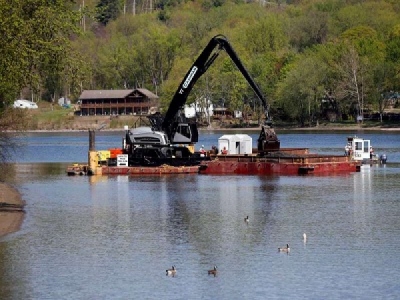
Posted on September 7, 2017
By Brian Nearing, TimesUnion.com
General Electric Co. took aim at New York state and federal agencies in a duel over science that claims the $1.7 billion PCB dredging project of the Hudson River has been a failure.
In a report filed Friday with the U.S. Environmental Protection Agency, which is considering whether to declare the seven-year project a success, GE called the state Department of Environmental Conservation “misguided” for urging EPA to order GE to do more dredging.
GE also called the National Oceanic and Atmospheric Administration (NOAA), which also favors more dredging, “inaccurate and misleading” in its 2016 study that claims PCB levels in fish will drop much more slowly than was predicted in 2002, when EPA and GE agreed to the cleanup plan.
DEC and NOAA are two of the three federal trustees for the Hudson, which are responsible for determining under a federal Natural Resources Damage Assessment whether GE is being held accountable for the damage caused by PCBs released into the river from factories in Fort Edward and Hudson Falls.
In a Friday report to EPA, NOAA Hudson River Case Manager Tom Brosnan said EPA has overestimated how quickly fish will recover from PCB levels that currently make them unsafe to eat.
Brosnan also wrote “very high levels of sediment PCB concentrations left behind (will) continue to contaminate and adversely impact natural resources, and the human use of those resources.”
In a letter last week to EPA Administrator Scott Pruitt, DEC Commissioner Basil Seggos said EPA “appears desperate to come to a conclusion which is simply not supported by the current conditions of the Hudson River … EPA has abandoned its responsibilities.”
While EPA set a Friday deadline for comments before the agency decides whether to declare dredging complete — which likely would remove future environmental liability from GE — Seggos said the state will submit its own tests for remaining PCB spots in the river with EPA this fall.
DEC has invested $2 million to gather 1,600 water and river bottom samples this summer from Troy to Fort Edward.
EPA also disputes the 2016 findings by NOAA and the U.S. Fish and Wildlife Service, the third federal trustee for the Hudson, that PCB levels in fish at the end of dredging were higher than had been predicted when the cleanup began.
GE dredged a 40-mile section of river from Fort Edward to Troy for seven years, under EPA oversight, before concluding in the late summer of 2015. The company has steadfastly maintained it has met the terms of it agreement with EPA and is not required to do any more.
Another scientific study that claims the cleanup won’t meet the goals set in 2002 was also submitted to EPA by the environmental groups Scenic Hudson and Riverkeeper.
That study, by the firm of S.S. Papadoulous and Associates, found that EPA’s predictions that fish could be again safe for regular human consumption within 55 years, or possibly later, were “so uncertain as to be meaningless.”
Several attempts to reach U.S. Fish and Wildlife officials for comment were not successful.
Source: timesunion





